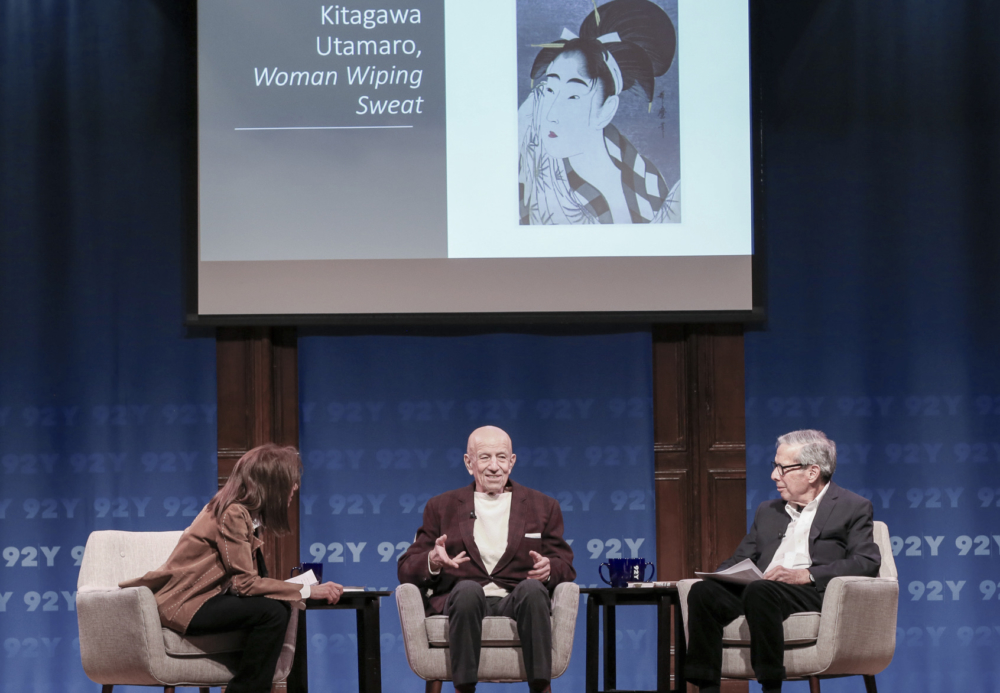Looking at Alex Katz as He Looks at Art

Only a painter could look at a large-scale architectural project as if it were a canvas. It’s one explanation, at least, as to why Alex Katz isn’t sweating the permanent installation of 17 large-scale paintings across the 400-foot train platform at the 57th Street subway station. “If they fuck it up, they’ll just have to do it again,” he said, sitting in the greenroom at the 92nd Street Y on a rainy night earlier this week. Wearing a faintly-checked wool blazer, white sweater, and a vintage Rolex, Katz appeared to scowl while he listened to questions but was affable as he responded to them. “How do the paintings look?” he repeated, with a dense voice that can best be described as “Brooklyn-like.” “They look sensational. It’s something that hasn’t been done before. The station was a totally depressing place before.”
As we spoke, young dancers in ballet tops weaved through a cluster of Katz’s associates, including his wife Ada, whom Katz estimates he’s painted over 200 times. The 90-year-old artist was at the Upper East Side events center, joined by the art writing power couple Dodie Kazanjian and Calvin Tomkins, to look at, and talk about, art in front of a sold-out room of people.
Katz’s new book, Looking at Art with Alex Katz, is essentially the same concept, just on the page, cycling through 90 of Katz’s favorite paintings, accompanied by blunt recollections of the work or his friendships with the artists who made them. Having famously survived the various fine-art bubbles and style cycles of New York City during his 60 years of painting, the book is less a tell-all and more a seen-it-all. When asked if it might be construed as instructional for, say, a less experienced viewer of art, Katz winced. “Everyone looks for themselves. People see whatever they want. I don’t tell anyone how to look at anything.”
Katz’s frankness has been labeled “abrasive” or “incisive.” His opinions seem to be spring-loaded, ready for any opportunity to pounce on willing listeners. Rembrandt? “His taste is kind of gross.” Hopper? “Always bothered me.” Caravaggio? “A lousy decorator, he could never make it in New York. Picasso? “An imaginative painter with a so-so technique. Nothing to write home about.” Matisse? “I couldn’t believe a human could have painted that well.” Hockney? “We’re related only in making the world pleasant. That’s about it.” Twombly? “Very good manners.” John Currin? “C’mon!”
When Kazanjian pulled up a slide of Warhol’s Birth of Venus, three 20s-something women sitting next to me slid forward in their seats. “Yes, yes!” one of them whispered eagerly. What did Katz think of the massive Warhol retrospective on display at the Whitney? “It’s an unfortunate show. A lot of it just looked like wrapping paper.”
“Is that a bad thing?” Kazanjian asked.
“Yeah,” Katz said, as the room cackled in unison. “The show didn’t do him justice.”
Once backstage, Katz was reminded that the Whitney was also having its annual art party, a slightly raucous (in an art world kind of way) gathering for New York’s latest crop of artists. Katz’s work is a part of the museum’s permanent collection. How would he look at art during a party? He winced, again. “Art should make people feel good. Tragedy is supposed to make you feel good, too.”






